- Our Catalog
- Philosophy
- Philosophers of the 20th century and today
- History of Philosophy (PUF)
- Counter-History and Brief Encyclopedia by Michel Onfray
- The philosophical work explained by Luc Ferry
- Ancient thought
- Thinkers of yesterday as seen by the philosophers of today
- Historical philosophical texts interpreted by great actors
- History
- Books (in French)
- Social science
- Historical words
- Audiobooks & Literature
- Our Catalog
- Jazz
- Blues
- Rock - Country - Cajun
- French song
- World music
- Africa
- France
- Québec / Canada
- Hawaï
- West Indies
- Caribbean
- Cuba & Afro-cubain
- Mexico
- South America
- Tango
- Brazil
- Tzigane / Gypsy
- Fado / Portugal
- Flamenco / Spain
- Yiddish / Israel
- China
- Tibet / Nepal
- Asia
- Indian Ocean / Madagascar
- Japan
- Indonesia
- Oceania
- India
- Bangladesh
- USSR / Communist songs
- World music / Miscellaneous
- Classical music
- Composers - Movie Soundtracks
- Sounds of nature
- Our Catalog
- Youth
- Philosophy
- News
- How to order ?
- Receive the catalog
- Manifesto
- Dictionnary











- Our Catalog
- Philosophy
- Philosophers of the 20th century and today
- History of Philosophy (PUF)
- Counter-History and Brief Encyclopedia by Michel Onfray
- The philosophical work explained by Luc Ferry
- Ancient thought
- Thinkers of yesterday as seen by the philosophers of today
- Historical philosophical texts interpreted by great actors
- History
- Books (in French)
- Social science
- Historical words
- Audiobooks & Literature
- Our Catalog
- Jazz
- Blues
- Rock - Country - Cajun
- French song
- World music
- Africa
- France
- Québec / Canada
- Hawaï
- West Indies
- Caribbean
- Cuba & Afro-cubain
- Mexico
- South America
- Tango
- Brazil
- Tzigane / Gypsy
- Fado / Portugal
- Flamenco / Spain
- Yiddish / Israel
- China
- Tibet / Nepal
- Asia
- Indian Ocean / Madagascar
- Japan
- Indonesia
- Oceania
- India
- Bangladesh
- USSR / Communist songs
- World music / Miscellaneous
- Classical music
- Composers - Movie Soundtracks
- Sounds of nature
- Our Catalog
- Youth
- Philosophy
- News
- How to order ?
- Receive the catalog
- Manifesto
- Dictionnary
MAHALIA SINGS PART 4
MAHALIA JACKSON
Ref.: FA1327
EAN : 3561302132723
Artistic Direction : JEAN BUZELIN
Label : Frémeaux & Associés
Total duration of the pack : 1 hours 2 minutes
Nbre. CD : 1
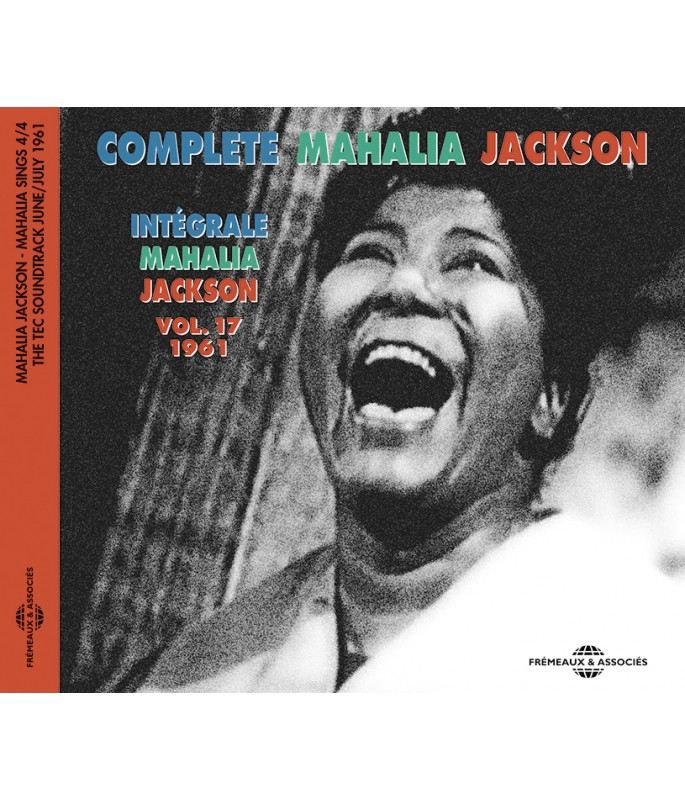
MAHALIA SINGS PART 4
MAHALIA SINGS PART 4
The four volumes of “Mahalia Jackson Sings” that form part of our Complete Mahalia Jackson comprise an exceptional recording and historical event. They contain the sound track of all the songs filmed by the TEC television channel in June and July 1961. Jean BUZELIN
The four CDs which we have produced and which are intended to be listened to as a whole, represent the result of long research and, in addition to being a world first, are an outstanding addition to the rich heritage left by the greatest Gospel singer of the 20th Century. Patrick FRÉMEAUX
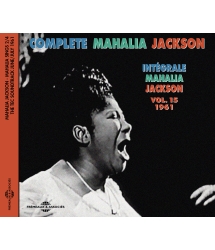
MAHALIA JACKSON
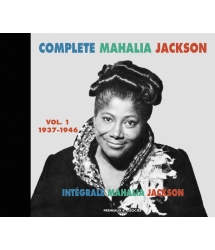
1937-1946
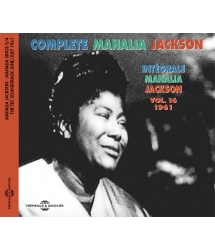
MAHALIA JACKSON
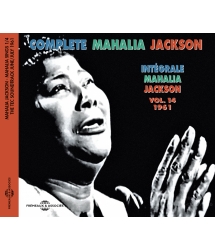
MAHALIA JACKSON





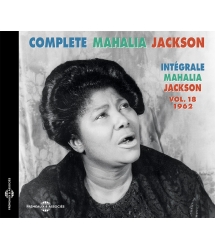
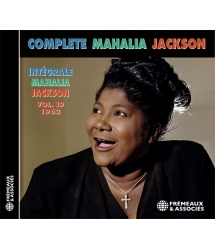
-
PisteTitleMain artistAutorDurationRegistered in
-
1An Evening Prayer (Dear Lord Forgive)Mahalia JacksonBattersby00:03:081961
-
2Where He Leads Me I Will FollowMahalia JacksonJ.S. Norris00:03:271961
-
3I Do, Don'T You ?Mahalia JacksonMiller00:03:231961
-
4I Want To Be A ChristianMahalia JacksonTraditionnel00:03:031961
-
5There Is Power In The BloodMahalia JacksonL.E. Jones00:03:051961
-
6Blessed QuietnessMahalia JacksonFerguson00:03:031961
-
7Elijah RockMahalia JacksonTraditionnel00:03:221961
-
8Because His Name Is JesusMahalia JacksonTraditionnel00:03:051961
-
9Have You Any Rivers (God Specializes)Mahalia JacksonO.C. Eliason00:02:531961
-
10The Only Hope We HaveMahalia JacksonM. Aikens00:02:461961
-
11Take My Hand Precious LordMahalia JacksonA. Dorsey Thomas00:02:191961
-
12I Found The AnswerMahalia JacksonJ. Lange00:03:041961
-
13I Know It Was The BloodMahalia JacksonTraditionnel00:03:211961
-
14Bless This HouseMahalia JacksonTraditionnel00:03:371961
-
15In The GardenMahalia JacksonC. Austin Miles00:03:251961
-
16God Be With You (Till We Meet Again)Mahalia JacksonW.G. Tomer00:03:121961
-
17Silent Night (Holy Night)Mahalia JacksonFranz-Xaver Gruber00:02:181961
-
18Sweet Little Jesus BoyMahalia JacksonFranz-Xaver Gruber00:03:211961
-
19A Star Stood Still (Song Of The Nativity)Mahalia JacksonJ. Ruth00:03:141961
-
20O Come All Ye Faithful (Adeste Fideles)Mahalia JacksonJ. Wade00:03:511961
CLICK TO DOWNLOAD THE BOOKLET
Mahalia vol.17 FA1327
COMPLETE MAHALIA JACKSON
INTÉGRALE
MAHALIA
JACKSON
VOL. 17
1961
INTÉGRALE MAHALIA JACKSON - VOL. 17 – 1961
Par Jean Buzelin
Les quatre volumes « Mahalia Jackson Sings » que nous vous présentons dans le cadre de notre Intégrale Mahalia Jackson, constituent un document et un évènement discographique exceptionnels. Ils contiennent en effet la bande sonore de la totalité des chansons filmées par la chaîne de télévision TEC en juin et juillet 1961. Certaines d’entre elles – une petite partie – avaient été publiées en microsillons 33 tours dans les années 70, puis reprises en CD sans aucune mention de dates ni de provenance, et avec une faible qualité sonore. Une partie plus importante de ces petits films, mais non l’intégralité malgré l’indication de l’éditeur qui les attribue à la NBC et non à la TEC, et dont les titres, mentionnés seulement sur internet, sont erronés ou hautement fantaisistes, a été publiée plus récemment en DVD.
Après une triomphale tournée de près de deux mois en Europe et au Moyen-Orient, Mahalia Jackson est de retour au pays vers la fin du mois de mai 1961, et pose ses valises chez elle à Chicago. Pas pour longtemps car, pendant son absence, son producteur de chez Columbia, Irving Townsend, et quelques autres, se sont occupés de la préparation des séances d’enregistrements filmés qui doivent être réalisés par la chaîne Television Enterprise Corporation, dont le président est un certain Harold Goldman. La chanteuse doit enregistrer quelques quatre-vingt-cinq chansons de 3 à 4 minutes en quinze jours, réparties en une dizaine de séances, soit environ huit par jour, en commençant à 9 heures du matin pour s’achever à 5 heures de l’après-midi. Ce qui n’est pas sans l’inquiéter. Après une tournée épuisante, elle n’a que trois semaines pour se reposer et se préparer. Mais comme chacun la persuade qu’elle est capable de relever ce défi, Mahalia se laisse convaincre et signe de bonne grâce le contrat. On prépare l’équipe : la fidèle Mildred Falls, qui l’accompagna en Europe, tiendra le piano en alternance avec Edward C. Robinson, et assumera la direction musicale ; Louise Overall Weaver sera à l’orgue, éventuellement suppléée en cas de besoin par Dorothy V. Simmons (du Simmons-Akers Trio) ; une section rythmique composée de trois musiciens de jazz tout terrain, Barney Kessel (guitare), Red Mitchell (contrebasse), Shelly Manne (batterie), à qui l’on demandera de bien marquer le gospel beat, complètera l’effectif musical1. Un secrétaire, Butch Thornton, s’occupe de l’intendance, et le tout est placé sous la direction artistique de Larry Peerce. Les enregistrements auront lieu aux studios de la Paramount, avenue Melrose à Hollywood. Le décor est spartiate et austère : quelques ogives « gothiques » découpées, parfois quelques arbres artificiels, des bancs, un vitrail, souvent rien du tout, des éclairages fixes, peu de mouvements de caméra. Cet environnement presque nu, qui peut paraître dicté par des raisons économiques, a le mérite de mettre en valeur Mahalia qui, filmée simplement et sans aucuns effets, diffuse une présence indéniable, forte et particulièrement prenante, notamment lorsque les gros plans s’attardent sur son visage qui laisse voir sa totale implication2.
D’après Laurraine Goreau, la biographe de Mahalia Jackson3, qui a sans doute assisté aux séances, une pause de 5 minutes était prévue chaque heure, ainsi qu’un break pour le déjeuner, les huit chansons devant être impérativement mises en boîtes pour 5 heures du soir. La première séance se serait ainsi déroulée dans l’ordre suivant : Where He Leads Me I Will Follow – Because His Name Is Jesus – Precious Lord – Holding My Savior’s Hand – In the Garden – You’ll Never Walk Alone – To Me, It’s So Wonderful – God Will Take Care of You. Et voici le programme de la seconde : Have Thine Own Way – Elijah Rock – God Be With You – Just As I Am – The Holy Bible – Hold Me – It Is No Secret – I’m a Child of the King. Ensuite, Laurraine Goreau ne poursuit plus l’énumération des titres de chaque séance, se contentant d’en citer par-ci, par-là quelques-uns3.
Mais ce travail intensif se fait aux dépends de ses cordes vocales. Après plusieurs séances, Mahalia a contracté une laryngite et sa gorge doit être soignée. Tout cela a des effets sur le planning, et le producteur téléphone quotidiennement, rappelant que chaque journée lui coûte 3 500 dollars de location du studio ! Les enregistrements reprennent car tout doit être bouclé pour le 30 juin. Mais, par la force des choses, il faudra déborder un peu, et la toute dernière séance a lieu le vendredi 7 juillet. Mahalia enregistre ce jour-là une série de chants de Noël : Silent Night, O, Come All Ye Faithful, O Little Town of Bethlehem, A Star Stood Still, Sweet Little Jesus Boy et Joy to the World.
84 petites bobines en 16 mm (des clips dirait-on aujourd’hui) sont ainsi mises en boîte et seront diffusées ultérieurement, les unes après les autres, sur la chaîne de télévision4. Tout le monde est enchanté : Townsend, Peerce, et particulièrement Mr Goldman. Chacun peut bien se féliciter, mais c’est avant tout Mahalia Jackson elle-même, l’artisane principale de cette magnifique série de chants sacrés de toutes sortes (negro spirituals traditionnels, hymnes composés, gospel songs…) ; sa voix extraordinaire atteint ici une plénitude exceptionnelle, une ampleur magistrale, une ferveur bouleversante.
Voici donc la bande sonore de l’intégrale des 82 titres diffusés par la chaîne de télévision ; ils ne sont pas présentés dans l’ordre chronologique, mais selon le classement établi par le collectionneur Mark Cantor, lequel fait autorité : « Ma numérotation est basée sur le registre principal des films. Je suis sûr qu’ils n’ont pas été enregistrés/filmés dans l’ordre de la liste, mais c’est ainsi que les producteurs l’ont eux-mêmes définie. »
Ces enregistrements filmés n’ont pas la qualité sonore des disques réalisés en studio à l’époque, en particulier chez Columbia, la maison de disques de Mahalia Jackson, mais nous avons effectué tout ce qui était possible, avec Christophe Heynault et Pierre Brousses du studio Art & Son, pour l’améliorer, même s’il reste quelques traces de pleurage qu’il est impossible de supprimer. Mais l’intérêt exceptionnel du document justifiait sa publication.
Cette intégrale « Mahalia Jackson Sings » présente la plus large sélection possible du répertoire de la chanteuse, et même bien au-delà. En effet, à côté des thèmes qui lui sont familiers et qui font partie, pour la plupart, de ses récitals habituels (You’ll Never Walk Alone, Joshua Fit the Battle, Didn’t It Rain, Down By the Riverside, It Don’t Cost Very Much, When the Saints, Elijah Rock, I Found the Answer…), on en relève quelques-uns qu’elle avait gravé au début de sa carrière (I Want To Rest -son premier disque Apollo en 1946, A Child Of the King - 1949, I Do, Don’t You - 1950). Enregistrés beaucoup plus récemment, d’autres sont toujours dans ses cordes (Somebody Bigger Than You And I, I Believe, My Lord, Holding My Savior’s Hand, I Want To Be a Christian, The Only Hope We Have…).
Mais, et ce n’est pas le moins étonnant, presque la moitié des titres est totalement inédite, et seuls une poignée d’entre eux sera enregistrée ultérieurement sur disque. D’où l’intérêt exceptionnel de leur publication. Il est d’ailleurs fort probable que Mahalia en ait appris certains pour l’occasion, ou qui ne lui sont pas familiers ; ainsi nous la voyons, à plusieurs reprises, tenir la partition en main pour déchiffrer les paroles en direct. Nous ne percevons pourtant la moindre hésitation, la moindre « faute » d’interprétation dans tous ces chants qu’elle a choisis, ou qui lui ont peut-être été proposés. Elle les fait siens, définitivement. Un tour de force et une série de performances exceptionnelles qui laissent l’auditeur – ou le spectateur – pantois et absolument transporté.
Croyez-vous que la chanteuse se reposa après une telle épreuve ? Pas du tout, le dimanche 16 juillet, elle chante au Madison Square Garden, à New York, dans un spectacle organisé par Joe Bostic, auquel participe une pléiade de grands noms du gospel, comme les Caravans avec Albertina Walker, et l’Ernestine Washington Temple Choir, et avec la présence de Martin Luther King qui apparaîtra sur scène juste avant Mahalia. Ces deux grandes figures de la « nation noire » n’ont pas fini de se rencontrer !
Notes :
1) En réalité, Edward Robinson jouera principalement de l’orgue – Dorothy Simmons ne semble pas avoir participé aux enregistrements – tandis que la section rythmique ne sera peut-être pas convoquée à toutes les séances, hormis peut-être Shelly Manne, car un certain nombre de chants, en particulier sur tempo lent, ne seront accompagnés que par le duo piano/orgue, avec parfois quelques ponctuations de percussions. Si Louise Weaver est une vieille complice de Mahalia, Edward Robinson apparaît ici pour la première fois dans l’entourage de la chanteuse ; on l’entendra ensuite souvent à l’orgue ou au piano et il deviendra son accompagnateur régulier après l’éviction brutale de Mildred Falls (on le verra au Festival d’Antibes en 1968). Quant à Shelly Manne et Red Mitchell, ils seront sollicités pour de futures séances de studio en 1962/63. Notons que les musiciens apparaissent à plusieurs reprises sur l’écran, Mildred Falls étant toujours au piano, Edward Robinson à l’orgue.
2) L’habillement de Mahalia Jackson se compose sobrement de deux aubes (une revêtue beaucoup plus que l’autre), parfois une robe longue blanche, et très rarement un tailleur et une robe imprimée.
3) Laurraine Goreau : Mahalia (Lion Pub., UK 1976 - 2e édition).
4) O Little Town of Bethlehem et Joy to the World, cités par Laurraine Goreau, n’apparaissent pas dans la liste des films établie par le collectionneur Mark Cantor ; il est fort possible qu’ils n’aient jamais été diffusés à la télévision. Mark Cantor répond à nos interrogations : « Il y a problème, de toutes manières, avec les titres de Noël. Maintenant, il me revient que ces films venaient des « 3 Complete sets » de courts-métrages, et édités à l’origine par les producteurs/distributeurs. Les collections sont complètes et peuvent ne pas correspondre avec les titres de chansons mentionnés par Laurraine Goreau dans son livre Mahalia. Je ne sais pas où elle a obtenu son information et d’où viennent les divergences, mais il y a quatre (et non six) titres de Noël dans la collection. Comme vous pouvez voir, les deux titres que vous mentionnez n’apparaissent pas comme ayant fait partie des films réalisés ; ils ont peut-être été proposés, voire filmés et enregistrés, mais pas réalisés dans les séries. »
La quatrième partie en détail
Les vingt titres qui clôturent cette incroyable aventure télévisuelle apparaitront peut-être, dans leur ensemble, un peu moins attrayants que les précédents. Il y a en effet beaucoup de morceaux chantés sur tempo lent et les simples accompagnements piano/orgue sont nombreux. De plus, contrairement au volume qui précède, Mahalia Jackson en avait déjà enregistré la plupart, signe par ailleurs qu’ils lui sont chers ! Mais il est bon d’y regarder à deux fois car l’on y trouve quelques pièces maîtresses, comme le fameux Precious Lord de Thomas Dorsey écrit en 1932 sous le coup de la douleur – il venait de perdre sa femme en couches et son enfant. Deux autres gospel songs sont très récents : I Found the Answer de Johnny Lange (1959) et The Only Hope We Have de Margaret Aikens (1960).
Parmi les negro spirituals, I Want To Be a Christian remonte très loin puisqu’il s’agirait d’un chant d’esclaves de Virginie datant du milieu du XVIIIe siècle, la musique en étant forcément plus récente. Elijah Rock bénéficie de la patte de l’arrangeur noir Jester Hairston. Né et mort avec le XXe siècle (1901-2000), il aurait exercé ses talents sur quelques trois cent spirituals. Because His Name Is Jesus et I Know It Was the Blood sont également des chants traditionnels.
Les trois hymnes qui ouvrent ce CD ont été composées au tournant du siècle ; vers 1911 pour An Evening Prayer, 1890 pour Where He Leads Me, et 1907 pour I Do Don’t You. Plus récent, God Specializes, est l’œuvre d’un évangéliste d’origine suédoise, Oscar Eliason.
There Is a Power In the Blood, de Lewis Jones (1899), Blessed Quietness, de Manie Ferguson, une évangéliste du Holiness Movement qui vit l’éclosion des églises sanctifiées (1897), et In The Garden, de C. Austin Miles, un auteur de gospels blanc (1913), s’inscrivent plus nettement dans le genre gospel hymns. Moins typés sont les cantiques Bless This House (1927) et God Be With You (1880).
Enfin, les quatre chants de Noël, qui s’ajoutent aux soixante-dix-huit titres numérotés, proviennent bien de la dernière séance de la série, la seule précisément datée du 7 juillet 1961. Deux, fort connus, sont d’origine européenne, Silent Night et le plus ancien Adeste Fideles, transcrit en anglais par un prêtre catholique en 1841 ; Sweet Little Jesus Boy est une pièce originale de Robert McGimsey (1932), l’auteur du célèbre Shadrack. Avec le Song Of the Nativity, ils ont déjà fait partie d’un LP paru en 1955 intitulé précisément « Sweet Little Jesus Boy » (voir Complete Mahalia Jackson Vol. 5 & 6), et seront réenregistrés dans un an en vue d’un nouvel album « Silent Night », à paraître dans un futur volume de notre intégrale.
Jean BUZELIN
© FRÉMEAUX & ASSOCIÉS 2017
Jean Buzelin est l’auteur de Negro Spirituals et Gospel Songs, Chants d’espoir et de liberté (Ed. du Layeur/Notre Histoire, Paris 1998) ; il collabore à la Gospel Discography de Cedric J. Hayes & Robert Laughton (rubriques Mahalia Jackson, Sister Rosetta Tharpe, Golden Gate Quartet, etc.).
Nous remercions particulièrement pour leur concours et leur aide Mark Cantor et Robert Laughton qui nous ont copié de rares films, ainsi que Philippe Baudoin et Isabelle Marquis, Patrice Buzelin, André Clergeat (†), Michel Pfau (†), Jean-Paul Ricard, Michèle et Joyce Waterhouse qui nous ont fourni de bonnes pistes de recherches.
Photos : X (D.R.)
COMPLETE MAHALIA JACKSON - VOL. 17 – 1961
By Jean Buzelin
The four volumes of “Mahalia Jackson Sings” that form part of our Complete Mahalia Jackson comprise an exceptional recording and historical event. They contain the sound track of all the songs filmed by the TEC television channel in June and July 1961. A small selection of these was issued on several long player records in the 70s and later reprised on CD, without any mention of date or provenance and with extremely poor sound quality. A larger extract of these small films has recently been issued on DVD but not the whole of them, in spite of the publisher claims attributing them to NBC rather than TEC and on which the titles, mentioned only on Internet, are either wrong or completely invented.
After a triumphant tour in Europe and the Middle East that lasted almost two months, Mahalia Jackson returned to Chicago in late May 1961. However, she didn’t stay at home very long as, during her absence, her producer at Columbia Irving Townsend, along with several others, had arranged several recording sessions to be filmed by the Television Enterprise Corporation channel, whose president was a certain Harold Goldman. She would have to record eighty-five songs, each lasting three to four minutes, over a period of fifteen days, roughly ten or so sessions which meant about eight a day, beginning at 9 in the morning and finishing around 5 in the afternoon. She wasn’t very happy about this. After a grueling tour she only had three weeks to rest and prepare herself. But after everybody persuaded her she was up to the challenge, Mahalia agreed to sign the contract. The backing group was chosen: the loyal Mildred Falls, who had accompanied her in Europe, on piano alternating with Edward C. Robinson, and also in charge of the music; Louis Overall Weaver on organ, to be replaced if necessary by Dorothy V. Simmons ( of the Simmons-Akers Trio). A rhythm section composed of three jazz musicians, Barney Kessel (guitar), Red Mitchell (double bass), Shelly Manne (drums), whose job it was to provide the Gospel beat, completed the line-up1. A secretary, Butch Thornton, was in charge of finances and the artistic director was Larry Peerce. The recordings took place at the Paramount Studios in Melrose, Hollywood. The décor was sparse and austere: some silhouettes of Gothic arches, a few artificial trees, benches, a stained glass window, sometimes nothing at all, fixed lighting and barely any camera movement. This almost empty setting, probably the result of cost cutting, had the advantage of placing the focus on Mahalia filmed very simply, without any additional effects, allowing her personality to dominate, particularly during the lingering facial close-ups that showed her complete involvement in what she was singing2.
According to Laurraine Goreau, Mahalia’s biographer3, who doubtless was present at the sessions, a 5-minute break was allotted every hour, as well as a break for lunch, but the final take of the eight songs had to be done by 5 o’clock in the evening. The titles from the first session were recorded in the following order: Where He Leads Me I Will Follow - Because His Name Is Jesus - Precious Lord - Holding My Savior’s Hand - In The Garden - You’ll Never Walk Alone - To Me, It’s So Wonderful - God Will Take Care Of You. And the second session: Have Thine Own Way – Elijah Rock – God Be With You – Just As I Am – The Holy Bible – Hold Me – It Is No Secret – I’m A Child Of The King. After this Laurraine Goreau no longer gives the programme for each session, merely mentioning some here and there3.
However, this intensive work load took its toll on Mahalia’s vocal chords. After several sessions, she got laryngitis and her throat had to be treated. All this affected the planning with daily phone calls from the producer reminding them that renting the studio was costing him 3,500 dollars a day! So the recordings began again and were definitely supposed to finish by 30 June but inevitably overran a little with the final session on Friday 7 July. On that day Mahalia recorded a series of Christmas songs: Silent Night, Oh Come All Ye Faithful, Oh Little Town Of Bethlehem, A Star Stood Still, Sweet Little Jesus Boy and Joy To The World. 84 small 16mm clips were put in the can to be broadcast later on television4. Everybody was delighted: Townsend, Peerce and especially Mr. Goldman. While they could all congratulate themselves, it was Mahalia Jackson herself who was the principal architect of this magnificent series of religious songs of all kinds (traditional Negro Spirituals, Hymns, Gospel songs…), her extraordinary voice soaring to exceptional heights or sinking to a beautiful sonority, the whole imbued with her own overwhelming and extremely moving fervor.
So here is the sound track of the entire 82 titles broadcast on television. They are not presented in chronological order but according to the classification by collector Mark Cantor, who specifies: “My designation of number is based on what is printed on the actual film credits. I am sure they were not filmed/ recorded in the order in the list, but this is how the producers themselves released them.”
Although the sound quality of these filmed recordings is not as good as studio recordings of the era, especially by Columbia, Mahalia’s regular recording company, we have done the utmost with the Art & Son studio to improve it, but there is still the occasional wow or flutter that was impossible to eradicate. However, the undeniable interest of the collection justifies its issue.
This complete “Mahalia Jackson Sings” includes the largest selection possible of the singer’s repertoire and even more. In addition to the titles that are associated with her and regularly formed part of her concerts (You’ll Never Walk Alone, Joshua Fit The Battle, Didn’t It Rain, Down By The Riverside, It Don’t Cost Very Much, When The Saints, Elijah Rock, I Found The Answer…), there are some that were recorded early in her career (I Want To Rest, her first Apollo record in 1946, A Child Of The King – 1949, I Do Don’t You – 1950). Other more recent recordings have always been part of her song sheet (Somebody Bigger Than You And I, I Believe, My Lord, Holding My Savior’s Hand, I Want To Be A Christian, The Only Hope We Have…).
Amazingly most of these titles have never been issued before and only a handful of them were later recorded on disc. Moreover, it is very likely that Mahalia was not familiar with several of them and learnt them for the show as we see her on more than one occasion holding the score to read the lyrics directly. However, there is never a sign of the slightest hesitation or glitch in her interpretation in any of the songs, whether she had chosen them herself or they had been suggested to her. An amazing feat and an impressive performance that leaves the listener – or the spectator – spellbound and completely carried away.
One may have thought that the singer would have taken a break after such a strenuous stint but not at all! Sunday, 16 July saw her singing at Madison Square Garden in New York, in a show organized by Joe Bostic, alongside a throng of Gospel greats that included the Caravans with Albertina Walker and the Ernestine Washington Temple Choir. Martin Luther King was also present and appeared on stage just before Mahalia. This was not the only time these two great personalities of the “African American” nation would meet!
Notes
1) In fact it is mainly Edward Robinson on organ – Dorothy Simmons does not appear to have taken part in the recordings – while the rhythm section was probably got together for each session, with the possible exception of Shelly Manne, for numerous titles, in particular slow tempo ones, are backed by a piano/organ duo, with occasionally the intervention of drums. If Louise Weaver was an old friend of Mahalia’s while this is Edward Robinson’s first appearance with the singer; later he was often heard on organ or piano and became her regular accompanist after the brutal sacking of Mildred Falls (he was at the Antibes Festival in 1968). Both Shelly Manne and Red Mitchell were invited back for studio sessions in 1962/63.
2) Mahalia was dressed soberly either in one of two surplices (one more decorative than the other), sometimes a long white robe or, very rarely, in a tailored jacket and a printed dress.
3) Laurraine Goreau: Mahalia (Lion Pub., UK 1976 – 2nd edition).
4) Oh Little Town Of Bethlehem and Joy To The World, mentioned by Laurraine Goreau, do not appear in collector Mark Cantor’s list of films based on the actual broadcasts: it is possible that they were never broadcast on television. The answer of Mark Cantor : “There is a problem, however, with the Christmas titles. Now, keep in mind that these films come from the three complete sets of the films shorts, as sent out by the original producer/distributor. The collections are complete, and they do not match the song titles as noted by Laurraine Goreau in her book Mahalia. I do not know where she got her information, and where the discrepancy arrises from, but these are the four (not six) Christmas titles in the collection. As you can see, the two titles that you note appear not to have been part of the released films; they may have been proposed, even filmed and recorded, but not released with the series.”
Part 4: Details
The twenty titles that close this incredible television event might seem overall less appealing than the preceding volumes. There are a lot of slow tempo vocals and numerous simple piano/organ accompaniments. Also, unlike the preceding volume, Mahalia Jackson had already recorded most of them, suggesting that they were among her favorites. But they merit a second hearing for they include several masterpieces such as the famous Precious Lord written by Thomas Dorsey in 1932 when he was mourning the death of his wife and baby in childbirth. Two other Gospel songs are more recent: I Found The Answer by Johnny Lange (1959) and Margaret Aikens’ The Only Hope We Have (1960).
Among the Negro Spirituals the slave song I Want To Be A Christian goes back much further to the mid-18th Century, although the music of course is more recent. Elijah Rock has an arrangement by the black arranger Jester Hairston (1901-2000) who worked on around three hundred Spirituals during his lifetime. Because His Name Is Jesus and I Know It Was The Blood are further traditional titles.
The three hymns that open this CD were composed around the turn of the century: An Evening Prayer towards in 1911, Where He Leads Me in 1890 and I Do Don’t You in 1907. The more recent God Specializes is the work of the Swedish Evangelist Oscar Eliason.
There Is A Power In The Blood by Lewis Jones (1899), Blessed Quietness (1897) by Manie Ferguson, an Evangelist of the “Holiness Movement” who witnessed the growth of sanctified churches and In The Garden (1913) by C. Austin Miles, a white Gospel composer, belong more to the Gospel Hymn category. Less typical are the two hymns Bless This House (1927) and God Be With You (1880).
Finally, in addition to the seventy-eight numbered titles, we have the four Christmas songs, which certainly come from the last session, the only one precisely dated 7 July 1961. Two of the most well-known originated in Europe, Silent Night and the older Oh Come All Ye Faithful, transcribed by a Catholic priest in 1841. Sweet Little Jesus Boy is an original piece by Robert McGimsey (1932), composer of the legendary Shadrack. Alongside the Song Of The Nativity, it had already appeared on an LP in 1955 entitled “Sweet Little Jesus Boy” (see Complete Mahalia Jackson Vo. 5 & 6) and would later be re-recorded in a precursor to a new album “Silent Night” to appear in a future volume of our Complete Mahalia Jackson.
Adapted from the French text
of Jean Buzelin by Joyce Waterhouse
© FRÉMEAUX & ASSOCIÉS 2017
Jean Buzelin is the author of Negro Spirituals and Gospel Songs, Songs of hope and freedom (Ed. du Layeur/Notre Histoire Paris 1998); he collaborated on the Gospel Discography by Cedric J. Hayes & Robert Laughton (sections on Mahalia Jackson, Sister Rosetta Tharpe, Golden Gate Quartet etc.).
With special thanks for their help and support to Mark Cantor and Robert Laughton who copied rare films for us, also Philippe Baudoin and Isabelle Marquis, Patrice Buzelin, André Clergeat (†), Michel Pfau (†), Jean-Paul Ricard, Michèle and Joyce Waterhouse who provided very useful research leads.
1. AN EVENING PRAYER (DEAR LORD FORGIVE) (C.M. Battersby - arr. C.H. Gabriel) - 63
2. WHERE HE LEADS ME, I WILL FOLLOW (J.S. Norris - E.W. Blandy) - 64
3. I DO, DON’T YOU? (E.O. Excell - M.W. Miller) - 65
4. I WANT TO BE A CHRISTIAN (Trad. - arr. B. Smith) - 66
5. THERE IS POWER IN THE BLOOD (L.E. Jones) - 67
6. BLESSED QUIETNESS (M.P. Ferguson) - 68
7. ELIJAH ROCK (Trad. - arr. J. Hairston) - 69
8. BECAUSE HIS NAME IS JESUS (Trad. - adapt. E.O. Excell) - 70
9. HAVE YOU ANY RIVERS? (GOD SPECIALIZES) (O.C. Eliason) - 71
10. THE ONLY HOPE WE HAVE (M. Aikens) - 72
11. TAKE MY HAND, PRECIOUS LORD (T.A. Dorsey) - 73
12. I FOUND THE ANSWER (J. Lange) - 74
13. I KNOW IT WAS THE BLOOD (Trad.) - 75
14. BLESS THIS HOUSE (M. Brahe - H. Taylor) - 76
15. IN THE GARDEN (C.A. Miles) - 77
16. GOD BE WITH YOU (TILL WE MEET AGAIN) (W.G. Tomer - J.E. Rankin) - 78
17. SILENT NIGHT (HOLY NIGHT) (F.X. Grüber - J. Mohr - arr. M. Jackson) - A
18. SWEET LITTLE JESUS BOY (R. McGimsey) - B
19. A STAR STOOD STILL (SONG OF THE NATIVITY) (B. Ruth - J. Broderick) - C
20. O COME ALL YE FAITHFUL (ADESTE FIDELES) (J.F. Wade - J. Reading -F. Oakeley) - D
Mahalia Jackson (vocal), with:
Mildred Falls (piano, musical director), Edward C. Robinson (organ, poss. piano on some tracks),
Louise Overall Weaver-Smothers (organ on some tracks), Barney Kessel (guitar), Keith M. “Red” Mitchell (bass), Sheldon “Shelly” Manne (drums, percussions); the rhythm section is not present on all the tracks.
Studios Paramount, Hollywood (CA), mid-June/early July 1961.
A TEC Production - distributed by Seven Arts Films.
Directed by Larry Peerce
Produced by Irving Townsend
Art director: Bob Dahlquist
Photography: Leugh Wiener
Lightning director: Robert Boatman
Technical director: Roy White
Camera: Baldwin Baker, Ray Figelski, Bill Matheson
Audio: Len Peterson
Video: Robert Spears
Video tape: Richard Krown
Stage manager: Hector Highton
Executive producer: Harold Goldman
Les quatre volumes « Mahalia Jackson Sings » que nous vous présentons dans le cadre de notre Intégrale Mahalia Jackson, constituent un document et un évènement discographique exceptionnels. Ils contiennent en effet la bande sonore de la totalité des chansons filmées par la chaîne de télévision TEC en juin et juillet 1961. Jean BUZELIN
The four volumes of “Mahalia Jackson Sings” that form part of our Complete Mahalia Jackson comprise an exceptional recording and historical event. They contain the sound track of all the songs filmed by the TEC television channel in June and July 1961. Jean BUZELIN
Les quatre CD réalisés par Jean Buzelin, inséparables et complémentaires, représentent le résultat de longues recherches et, au-delà d’une première mondiale, sont un témoignage patrimonial exceptionnel qui enrichit magistralement l’œuvre de la plus grande chanteuse de Gospel du XXe siècle.
Patrick FRÉMEAUX
The four CDs which we have produced and which are intended to be listened to as a whole, represent the result of long research and, in addition to being a world first, are an outstanding addition to the rich heritage left by the greatest Gospel singer of the 20th Century.
Patrick FRÉMEAUX
MAHALIA JACKSON Vol. 17 – 1961 - MAHALIA SINGS Part 4
1. AN EVENING PRAYER 3’08
2. WHERE HE LEADS ME, I WILL FOLLOW 3’27
3. I DO, DON’T YOU? 3’23
4. I WANT TO BE A CHRISTIAN 3’03
5. THERE IS POWER IN THE BLOOD 3’05
6. BLESSED QUIETNESS 3’03
7. ELIJAH ROCK 3’22
8. BECAUSE HIS NAME IS JESUS 3’05
9. HAVE YOU ANY RIVERS? (GOD SPECIALIZES) 2’53
10. THE ONLY HOPE WE HAVE 2’46
11. TAKE MY HAND, PRECIOUS LORD 2’19
12. I FOUND THE ANSWER 3’04
13. I KNOW IT WAS THE BLOOD 3’21
14. BLESS THIS HOUSE 3’37
15. IN THE GARDEN 3’25
16. GOD BE WITH YOU (TILL WE MEET AGAIN) 3’12
17. SILENT NIGHT (HOLY NIGHT) 2’18
18. SWEET LITTLE JESUS BOY 3’21
19. A STAR STOOD STILL (SONG OF THE NATIVITY) 3’14
20. O COME ALL YE FAITHFUL (ADESTE FIDELES) 3’51










